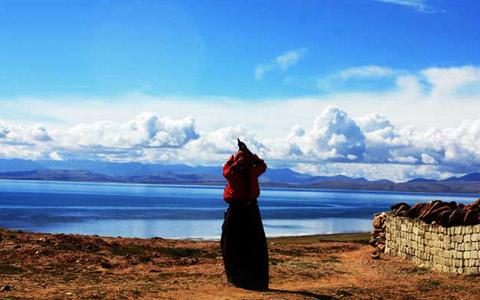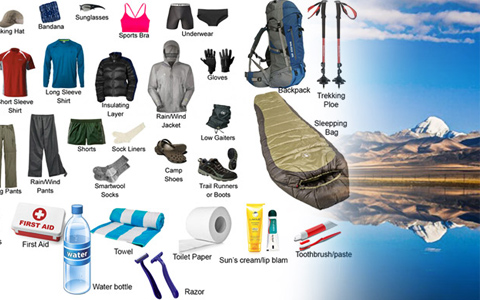Climbing Mount Kailash: Can I Climb Up to Mount Kailash? Is It Allowed?
Mount Kailash, with its awe-inspiring presence and profound religious significance, has long captured the imaginations of adventurers and spiritual seekers alike. Many individuals yearn to conquer its majestic heights, but the question remains: Can one climb up to Mount Kailash? Is it even allowed?
In this article, we will delve into the reasons behind the restrictions and explore alternative ways to experience the spirituality of this sacred mountain.
 Can I Climb Up to Mount Kailash? Is It Allowed?
Can I Climb Up to Mount Kailash? Is It Allowed?
 Why Mount Kailash is Unclimbable: Physical Challenge
Why Mount Kailash is Unclimbable: Physical Challenge
 Has Anyone Climbed Mount Kailash? Past Attempts
Has Anyone Climbed Mount Kailash? Past Attempts
Can I Climb Up to Mount Kailash? Is It Allowed?
Climbing Mt Kailash is not Allowed due to Religious Reason
Climbing Mount Kailash is not permitted primarily due to its unique religious significance. Lying in the far west of Tibet, in the Gangdise Mountain Range, Mount Kailash is the most sacred mountain in the world and holds immense importance in four religions, including Buddhism, Hinduism, Jainism, and Bon.
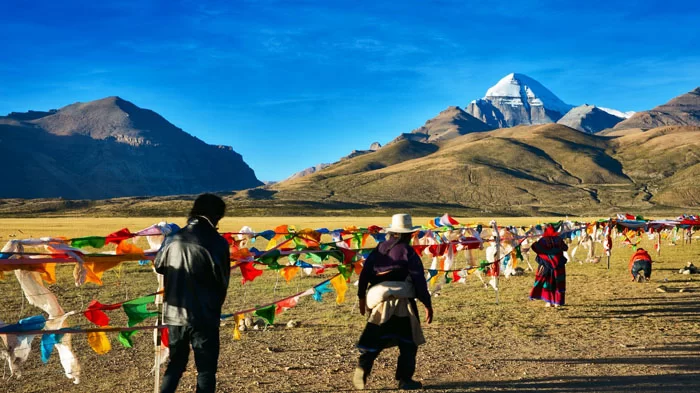 Mount Kailash is regarded as the most sacred mountain in the world by four religions.
Mount Kailash is regarded as the most sacred mountain in the world by four religions.
It is considered a sacred place of pilgrimage, revered by millions around the world. To honor the sanctity and preserve the spiritual significance of Mount Kailash, climbing it is prohibited. The mountain's elevated status as a symbol of spiritual enlightenment and divine presence calls for reverence rather than an act of conquering its physical summit.
Legends of Mount Kailash in Four Religions
As a prominent mountain in the beliefs of four religions, Mount Kailash has many legends. Some are believed to be true, while others are cherished as part of the religious beliefs held by millions worldwide.
In Buddhism, Mount Kailash is known as Gang Rinpoche, which translates to “Precious Snow Mountain”. It is believed to be the legendary Mount Meru, the center of Buddhist cosmology. Many Buddhists come from all over the plateau, walking for a thousand kilometers, to pray and prostrate along the sacred kora route at the mountain's base.
One famous legend of Mount Kailash in Tibetan Buddhism is the legend of Milarepa and Naro Bon-Chung. It is said that Milarepa, the Buddhist champion, challenged Naro Bon-Chung, the champion of the Bon religion in Tibet, over the mountain. To settle the dispute, they raced to the summit, with Milarepa winning by ascending on a ray of sunlight. He claimed the mountain for Buddhism but graciously bestowed Mount Bönri to the Bonpo.
In Hinduism, Mount Kailash represents the legendary mountain known as Kailāsa, where Lord Shiva and his wife, Pārvatī, meditate eternally. It is believed to have four golden, ruby, crystal, and lapis lazuli sides, forming the shape of a perfect lotus at the heart of six other mountains. The Kailash Manasarovar Yatra is a pilgrimage of a lifetime for many Indian Hindus, with hundreds of thousands applying for the journey but only a few thousand get chosen.
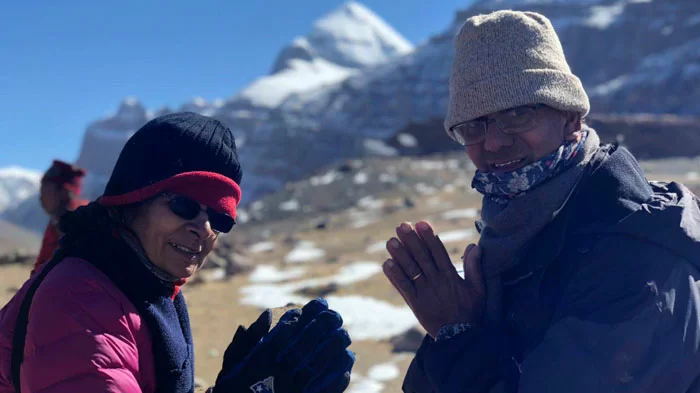 The Kailash Manasarovar Yatra is a lifetime pilgrimage for many Indian Hindus.
The Kailash Manasarovar Yatra is a lifetime pilgrimage for many Indian Hindus.
In Jainism, Mount Kailash is considered the legendary Mount Meru, the center of the entire universe. According to the Jain scrolls, the nearby Mount Ashtapada is the site where the first Jain master, a Tirthankara known as Rishabhadeva, attained his enlightenment, or moksha in Jainism.
In Bon, Mount Kailash is known as the earthly representation of the TagzigOlmo Lung Ring, or the “nine-story Swastika mountain”. Known as the “axis mundi” in Bonpo, Mount Kailash is the world axis, and is considered to be the connection between heaven and earth. It acts as the axis mundi, facilitating communication between the Bon deities and people, with blessings descending and prayers ascending.
Why Mount Kailash is Unclimbable: Physical Challenge
Aside from religious reasons, Mount Kailash is considered impossible to climb due to its physical challenges.
The mountain's pyramid-like shape, steep slopes, and constant snow cover make it incredibly difficult. The summit stands out from the surrounding peaks with its symmetrical walls reaching high into the sky. The slopes are almost vertical, making it an extremely tough task for climbers.
Additionally, the mountain is plagued by powerful winds that create a dangerous environment. These gusts, combined with harsh weather conditions at high altitudes, make it hard to maintain stability and make progress.
The steep inclines, extreme temperatures, thin air, and challenging terrain all make climbing Mount Kailash an impossible achievement that requires immense physical endurance and mountaineering expertise, which only a few possess.
Has Anyone Climbed Mount Kailash? Past Attempts
At just 6,638 meters above sea level, the mountain is far from being one of the highest mountains in Tibet, yet it has never been climbed by modern man.
A pyramid of black rock that stands tall above its compatriots, Mount Kailash has attracted the interest of mountaineers since its discovery by western explorers almost a century ago. However, thanks to the intervention of the Chinese government in response to the mounting concern that a Spanish team was getting ready to climb the mountain, the holy peak will forever remain just that.
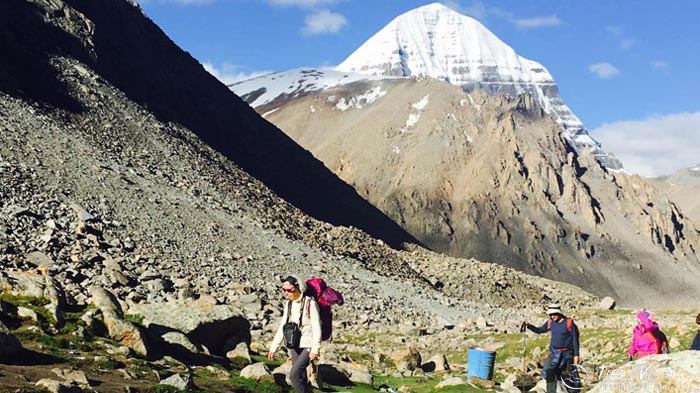 The Mount Kailash has attracted many trekkers and explorers since its discovery.
The Mount Kailash has attracted many trekkers and explorers since its discovery.
In 1926, the famous mountaineer, Hugh Ruttledge, began his study of the north face of the mountain. He estimated the height back then at around 6,000 feet above the plateau, and was advised that the mountain was “utterly unclimbable” by the British Mountaineering Association. During his study of the north face, he believed that he may have discovered a way to reach the summit, but ran out of time and the snow cut off any hope of making the ascent.
Similarly, to the south, Colonel R. C. Wilson also considered the climb, and was advised by his Sherpa companion that it could definitely be climbed. He too ran out of time, with the harsh Tibetan winter drawing close, and gave up the idea for the time being, never to be able to return to fulfill his ambitions.
In 1936, Australian author and climber, Herbert Tichy, while exploring the area around GurlaMandhata, wondered if Mount Kailash would be an easy climb. When he asked a local lama if the mountain could be climbed, the lama told him that "Only a man entirely free of sin could climb Kailash. And he wouldn't have to actually scale the sheer walls of ice to do it - he'd just turn himself into a bird and fly to the summit."
It was not until the middle of the 1980s that an expedition was actually considered, and permission was given to Reinhold Messner, the Italian mountaineer, who made the first solo ascent of Mount Everest. Messner actually declined the proposition. Messner said that the mountain was considered holy, which was the reason he declined the expedition offer. He said: “If we conquer this mountain, then we conquer something in people's souls. I would suggest they go and climb something a little harder. Kailash is not so high and not so hard.”
Alternative Way to Experience Mount Kailash: 3-day Kora
Though mountain climbing is not allowed on Mount Kailash, you can take a 3-day Kailash Kora to closely feel the spirit of the holy mountain.
 Our clients are taking the 3-day Mount Kailash Kora.
Our clients are taking the 3-day Mount Kailash Kora.
Mount Kailash Kora refers to the sacred circumambulation of the mountain. It is believed that completing the circumambulation of Mount Kailash can purify one's sins, bring spiritual blessings, and lead to enlightenment.
During the kora, you can see the summit of Mount Kailash from different angles up close. You will trek through breathtaking landscapes, ancient monasteries, and sacred sites, and immerse yourself in the spiritual ambiance that surrounds the mountain.
To embark on Mount Kailash Kora, it is important to be well-prepared and informed. The journey requires physical stamina, as the terrain can be challenging at times. Proper acclimatization to the high altitude is crucial, as it significantly reduces the risk of altitude sickness.
It is advisable to book your Mount Kailash tour with a reputable tour operator like us, to enjoy a smooth and enjoyable journey. Once you book your Kailash tour with us, we will handle all the details for you, including applications for all required travel documents, accommodations and meals, and thoughtful local Tibetan guides. We provide a 100% guaranteed Tibet Permit for all our customers.
Conclusion
In conclusion, climbing Mount Kailash is not allowed due to its religious significance and the physical challenges it presents. However, Mount Kailash Kora offers an alternative path to experience the spirituality and mysticism of this sacred mountain.
This 3-day trek journey is the best way to get close to Mount Kailash, enabling pilgrims and tourists to connect with the mountain, and feel its powerful energy. So, if you're considering a visit to Mount Kailash, don't hesitate! Pack your bags and embark on this uplifting journey!

The Lhasa-born prodigy used to study business overseas, and got his Bachelor of Business in Nepal and India before moving back to his homeland. With pure passion for life and unlimited love for Tibet, Kunga started his guide career as early as 1997.
Responsible, considerate, and humorous, he devoted his entire life to guiding and serving international tourists traveling in Tibet. As a legendary Tibetan travel guru with 20-year pro guide experience. Currently, he is working in Tibet Vista as the Tour Operating Director. Whenever our clients run into trouble, he is your first call and will offer prompt support.
Related Articles & Posts
Most Popular Tibet Tour Packages
-

Lhasa - Gyantse - Shigatse - Everest Base Camp - Shigatse - Lhasa
USD939
View Details -

Lhasa - Gyantse - Shigatse - E.B.C - Saga - Kailash Trek - Darchen - Lake Manasarovar - Saga - Gyirong - Tingri - Lhasa
USD2059
View Details -

10 Days Lhasa to Everest Base Camp and Namtso Lake Small Group Tour
Lhasa - Gyantse - Shigatse - EBC - Shigatse - Lhasa - Namtso Lake - Damxung - Lhasa
USD1289
View Details -

8 Days Driving Across Himalaya Overland Adventure from Kathmandu to Lhasa
Kathmandu - Gyirong - Everest Base Camp - Tingri - Shigatse - Gyantse - Lhasa
USD1069
View Details -

4 Days Lhasa Impression Small Group Tour: Explore the Heart of Tibet and Mingle with the Locals
Lhasa
USD509
View Details -

Lhasa - Gyantse - Shigatse - Everest Base Camp - Gyirong - Kathmandu
USD979
View Details -

Lhasa - Gyantse - Shigatse- Lhasa
USD799
View Details -

13 Day Lhasa, Mt. Everest, Mt. Kailash, Lake Manasarovar and Kathmandu Adventure Tour
Lhasa - Gyantse - Shigatse - EBC - Saga - Darchen - Kailash Trek - Darchen - Saga - Gyirong - Kathmandu
USD2059
View Details


.jpg)




